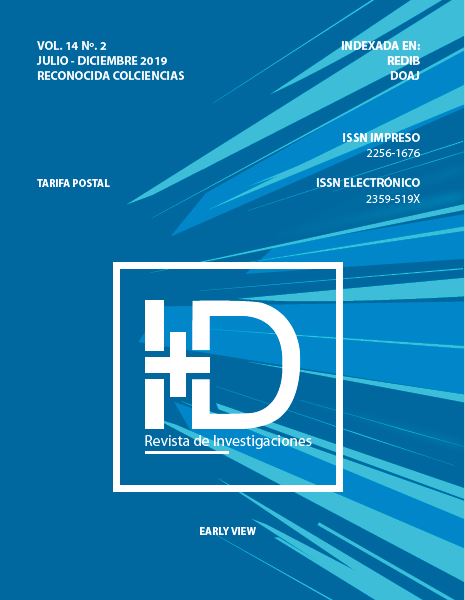Application of the EWMA chart based on the effective variance to monitor variability in fungicides multivariate quality control processes
DOI:
https://doi.org/10.33304/revinv.v14n2-2019003Keywords:
Effective variance, EWMA charts, multivariate process.Abstract
This article presents a case study, using a monitoring using the EWMA control chart based on effective variance, to show how the increase in variability of one quality characteristics affects the user in a sensitive way the results for this type of carte; in addition, this allows to expand the capacity to select different monitoring methods for multivariate process. In this study, subgroups submitted online were evaluated in the line of a manufacturing process of plant protectants or fungicides using two variables resulting from the process, established the parameters. When analyzing the EWMA control chart based on effective variance, was found that it generates very closed limits, which could be detrimental to samples with high variability.Downloads
References
Acosta-Mejía, C., Pignatello, J., & Reo, V. (1999). A comparation of control charting procedures for monitoring process dispersion. IIE Transactions, 31(6), 569–579.
Alt, F.B., & Smith, N.D. (1998). Multivariate Process Control. Handbook of Statistics 7, 333-351.
FRAC (2016) (Fungicide resistance action committee), Clasificación de fungicidas. Recuperado de https://www.queaplico.com/biblioteca?id=7fungicidesSpanish.aspx
Garcias, J. C. (2007), The Effective Variance Control Chart for Monitoring the Dispersion process with Missing data, European J. Industrial Engineering 1, 40-55.
Hawkins, D.M, (1981). A CUSUM for a scale parameter. Journal of Quality Technology, 13(4), 228-231.
Hawkins, D.M, (1993). Cumulative Sum Control Charting: An Underutilized SPC Tool. Quality Engineering, 15(3), 463-477.
Herrera, R. J., Mendoza, A., & Fontalvo, T. (2016). Comparación de las Cartas de Control Univariadas con Transformación en la Medida de Variabilidad. Ingeniare, (13), 51–57.
Herrera, R. J. (2006). Seis Sigma Métodos Estadísticos y sus Aplicaciones. Ecoe Ediciones, pp. 56.
Hock, W. K. (2012) “Effect of pH on pesticide stability and efficacy,” Pesticide Safety Education Program (PSEP). Cornell University. Recuperado de http://psep.cce.cornell.edu/facts-slides-self/facts/gen-peapp-ph.aspx.
Karaoglan, A. D., & Bayhan, G. M. (2012). ARL performance of residual control charts for trend AR (1) process: A case study on peroxide values of stored vegetable oil. Scientific Research and Essays, 7(13), 1405–1414.
Koshti, V. V (2013). Cumulative sum control chart. International Journal of Physics and Mathematical Sciences, 1(1), 28-32.
Leiva P. D. (2010). Consideraciones generales sobre calidad del agua para pulverización agrícola. INTA. Argentina
Lyr, H., Russell, P. E., & Sisler, H. D. (1996). Modern Fungicides and Antifungal Compounds. Andover, United Kingdom.: Intercept Limited.
Martínez, I., & Guzmán, M. (2011). Guía básica para la preparación de mezclas, uso de fungicidas y calibración de motobombas utilizadas en el combate de la Sigatoka negra. Oeste, 300(1).
McGrath, M.T. (2014) “¿Qué son los fungicidas?” The Plant Health Instructor. Trans. L. Santamaría, J.C Ureta, Cornell University. Recuperado de http://www.apsnet.org/EDCENTER/INTROPP/TOPICS/Pages/
Melgarejo, J., & Abella, F. (2011). Mecanismo de acción de los fungicidas. Revista Ventana Al Campo, 193–202.
Montgomery, D. C (2001). Introduction to statistical Quality Control. Wiley, New York, United States.
Montgomery, D.C. (1995). Control estadístico de la calidad. Limusa, 3a Edición, ciudad de México, México, pp. 406-424.
Morales, V. H. & Vargas J. A. (2008), Carta EWMA con varianza efectiva para monitorear variabilidad en procesos de control de calidad multivariado. Colombia.
Peña, D. & Rodriguez J. (2003), Descriptive Measures of Multivariate Scatter and Linear Dependence, Journal of Multivariate Analysis 85, pag.361-374.
Wilks, S. S. (1932), Certain Genereralizations in the Analysis of Variance, Biometrika 24, pag. 471-494












